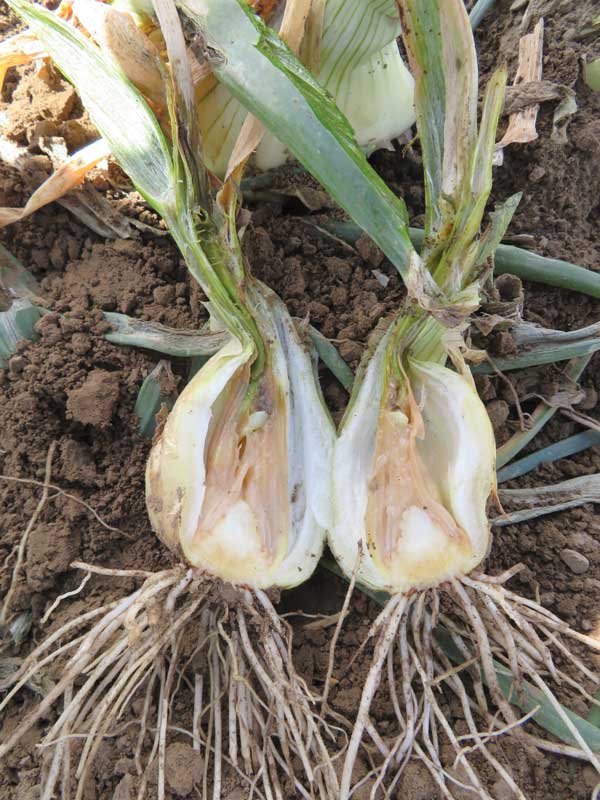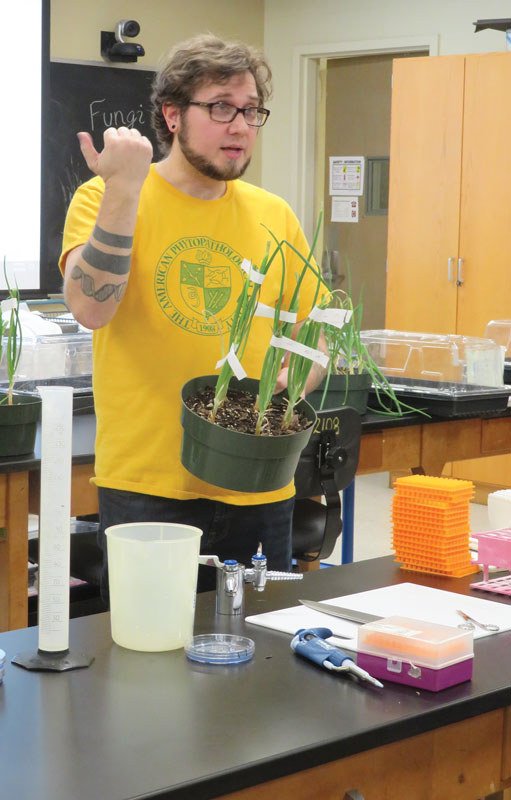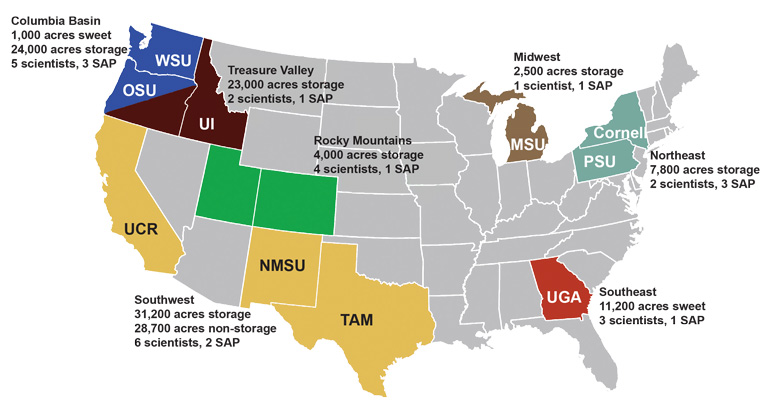National U.S. Team to Combat Bacterial Diseases of Onion with Fierce Collaboration
By Christy Hoepting, Cornell Vegetable Program, Cornell Cooperative Extension; and Lindsey du Toit, Department of Plant Pathology, Washington State University
When Washington State University (WSU) plant pathologist and onion enthusiast, Dr. Lindsey du Toit, announced that she was going to lead a multi-state, multi-disciplinary, multi-million dollar project on bacterial bulb rot of onion, I said “Sign me up. I want to be on your team!” I have been an onion specialist with Cornell Cooperative Extension in New York for 20 years. During this time, I have experienced some pretty exciting breakthroughs in weed and disease management, but never for bacterial diseases.
Bacterial bulb rot is the arch nemesis of U.S. onion production. This sentiment is echoed across the country, where bacterial pathogens of onion cause more than $60 million in losses annually to our $925 million, 140,000-acre industry. Losses can be particularly severe for stored bulbs as bacterial bulb rots typically develop in storage after all production costs have been incurred.
In a preliminary pre-project survey of a sample of onion stakeholders, 72 percent were extremely or very concerned about challenges from bacterial diseases, with 45 percent feeling poorly equipped to manage them. The goal of this new project is essentially to skew these numbers in the other direction.

Ambitious Team
The “Stop the Rot” project, officially titled “Combating onion bacterial diseases with pathogenomic tools and enhanced management strategies,” is funded by a grant from the USDA National Institute of Food and Agriculture (NIFA) – Specialty Crops Research Initiative (SCRI). The project organizes 24 scientists in 10 diverse disciplines across seven onion growing regions in 12 states, as well as an international phyto-bacteriologist from South Africa.
With fierce collaboration built on longstanding partnerships, we will research the complete system (host, pathogen and environment) of bacterial diseases of onion to develop practical, economically sound strategies for pathogen detection and management that will improve profitability and sustainability of onion production. The project duration is 2019-2022.
Grassroots Approach
Two years prior to the project getting funded, researchers and extension educators began meeting regularly with onion growers and seed company representatives to hash out specific issues and needs related to bacterial diseases. Stakeholders informed us they want to be able to predict bacterial bulb rot incidence, as this is often unknown as harvest approaches.
In response, a computer scientist and data modeler were added to the team to mine copious amounts of data on crop production, microclimate and bacterial rots to develop models that will predict risks of bacterial diseases. This kind of information can help a grower decide whether to sell a crop immediately if there is a high risk of bulb rot or hold the crop for longer-term storage and a higher market price if there’s a low risk of bulb rot.
Evaluation of injecting disinfectants into storages was also added to the project upon the request of stakeholders.
Formally, the Stop the Rot project has 13 Stakeholder Advisory Panel (SAP) members that are integrated into all aspects of the project to ensure a grassroots approach to developing economically feasible strategies to manage onion bacterial diseases effectively in the “real onion world.”
Most importantly, stakeholders provided $2,014,000 (24 percent) of the total $8.2 million budget for the project, or half of the third-party matching funds, via donations of time and resources. USDA-NIFA funds in the amount of $4,044,000 were awarded, with the remaining $2,186,000 made up of matching funds from collaborating universities.

Main Objectives
Our efforts in the Stop the Rot project consist of two main parts: a) characterizing bacterial pathogens of onion across the U.S. and b) developing effective management practices for onion growers.
Objective A focuses on onion bacterial disease characterization – “know the enemy”:
- Conduct a national onion bacterial disease survey and develop the National Onion Bacterial Strain Collection (NOBSC)
- Evaluate onion bacterial pathogenomics
- Develop onion bacterial disease detection tools
- Develop onion screening protocols for evaluating resistance to bacterial pathogens
The NOBSC and the phenotypic resistance screening methods developed by this team will, ultimately, provide effective tools for breeders to screen and develop onion cultivars with resistance to bacterial diseases.
Bacterial bulb rots of onion are complex. Burkholderia, Pantoea, Enterobactor and Xanthomonas are the most common genera of bacteria causing diseases of onion in the U.S. However, they can cause very similar symptoms. Which genera and species are present, and the symptoms they cause, depends on the production region and season (Table 1).
A single bulb can have dozens of bacterial species and even different strains of the same species, some of which may be harmless and others highly virulent on onion, a.k.a. “rotters.” Diagnosing the primary cause of bacterial rot in an onion bulb is a laborious process, from choosing which section of rotten bulb to sample, to selecting the type of media used to isolate the bacteria and deciding which molecular tests to use. Five labs given the same sample could, conceivably, get five different diagnoses.
Labs involved in this project will use standardized procedures for every step of the way for every onion sample. Plants and bulbs will be sampled from multiple fields and storage units three times a season in each of 12 states for three seasons – that’s a lot of rot! From these, approximately 1,000 bacterial strains will be stored permanently in a public National Onion Bacterial Strain Collection (NOBSC), each one characterized on the basis of its DNA fingerprint and the ability to cause onion rot. This will provide an invaluable resource for future research on onion bacterial diseases.
We will sort the good guys from the bad guys. Pathogenomics is a means of sorting out which strains of bacteria cause disease (pathogenic or virulent) from those that are harmless (non-pathogenic) based on the genetic fingerprints of the strains. This is a relatively new frontier in bacterial diseases of onion. It is a crucial part of the Stop the Rot project because it will yield fast and accurate diagnostic tools that complement the current laborious and less accurate methods which have been a barrier to effective management of onion bacterial diseases. Essentially, pathogenic and non-pathogenic bacterial strains will be sorted through a series of physical tests and close examination of their DNA sequences. With this information, molecular diagnostic tools will be developed, similar to the way in which DNA fingerprinting is used in forensic science to “identify the killer.”
Developing the DNA fingerprints is a fairly standard research method now, but designing the molecular diagnostic tools entails more complicated research. We will start with Pantoea ananatis, followed by P. agglomerans, based on preliminary work accomplished by bacteriologists on our team. The same approach may be used for other bacterial species. These new tools will help us identify inoculum sources, such as infested soil, water and weed hosts, and develop reliable phenotypic screening methods to identify varietal resistance to bacterial diseases.
Objective B focuses on management practices for onion bacterial diseases:
- Irrigation management (amount and frequency, tapering and ceasing irrigation)
- Fertility management with an emphasis on nitrogen (amount and timing, interaction with irrigation)
- Pesticide programs (efficacy of copper bactericides, sanitizers, biologicals, plant defense activators)
- Cultural management (undercutting, rolling tops and timing of topping for field curing)
- Post-harvest management (efficacy of postharvest curing and desiccants or sanitizers injected into storage units)
- Bacterial disease modeling
Specific aspects of managing onion bacterial diseases investigated across the U.S. will be prioritized based on regional practices and constraints and on stakeholder priorities. Trial design and research protocols will be refined each year based on stakeholder feedback. With field trials carried out in seven regions on common objectives and treatments each year for three seasons, we will identify the most important practices that help control bacterial pathogens and will integrate these into effective regional management programs for bacterial rots. Economic assessments will be made every step of the way to ensure that growers have practical and cost-effective tools to solve bacterial diseases in onion production


